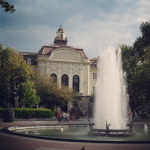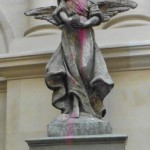We spent three nights in Veliko Tarnovo, in Bulgaria. it was the former capital of The Second Bulgarian Kingdom from 1185 until it was conquered by the Ottomans in 1422. The Ottomans rule ended after the country was liberated during the Russo-Turkish war of 1878. It has left an interesting city with lots of Ottoman style houses which date from the 456 years of Turkish rule.
On our first day in Veliko Tarnovo after a night of rain we woke to a beautiful clear sunny day. The perfect weather for a Free Walking Tour. We headed to the Tourist Information Centre where we met Plami our guide. Plami and a few of her friends conduct Free Walking Tours around Veliko Tarnovo. We got chatting and soon discovered that these tours are actually run by locals.
Unlike the Free tours, we’ve been on throughout Europe, there are no group photos so that the “Free” company can charge the guide an amount per head. There are no middle men to be paid.
You are not asked for money or told how the “Free Tour Works” in regard to paying the guide. These are actually “Free” walking tours. If you choose to tip the guide, well that’s your decision, but they are struggling students and it’s nice to know that your money isn’t being shared amongst the managers.

Veliko Tarnovo is an interesting city as it’s built on a hills overlooking the Yantra River which meanders its way through the city. Due to the lack of flat land there’s no city square however there’s a few statues which are local meeting points.
In the centre of Veliko Tarnovo is the St. Cyril and St. Methodius University and we learnt that the university was named after the two famous brothers who invented the Glagolitic alphabet. It was the first Slavic phonetic alphabet so that anyone who can read the language can say the words. It was developed in Moravia in 863 and eventually used throughout the Byzantine empire. St. Cyril and St. Methodius’ followers later developed another slavic alphabet which eventually replaced it naming it Cyrillic after the earlier creator. Bulgaria is quite proud that Cyrillic was developed in Bulgaria during the first Bulgarian Kingdom and has become the main Slavic alphabet.
On the tour Plami told us about Bulgarian history which dates back to 681 when Bulgar tribes settled in the Veliko Tarnovo area after defeating the Byzantine army. It was a tumultuous history of wars and struggle as the land changed hands several times. Firstly the Byzantines under Emperor Basil II conquering the kingdom in 1014, and then after establishing their Kingdom again in 1185 they were conquered by the Ottomans in 1422. The 456 year rule by the Ottomans was brought to an end with the help of Russia during the Russo-Turkish War. She told us how the Great Powers objected to the size of the Third Bulgarian State with the borders of their former empire as it conflicted with their own interests in the region. The subsequent restriction to a smaller state under the Treaty of Berlin was to form Bulgaria’s foreign policy and alliances during the 19th and 20th century.
The smaller state was one of the reasons why Sofia, near the border was selected as the capital. With a large Bulgarian population outside the borders The Bulgarian Kingdom with the help of the Austro -Hungarians had ambitions of expanding into their former territories where Sofia would be in the middle of the country, but it was not to be.
Walking through the city we spotted a mixture of new and old renaissance style buildings. Not far from the University is a tourist street with souvenir shops, restaurants and cafe’s. It’s the place to find lots of local produce such as rose products, like oil and almost anything which rose can be put into. There’s also Bulgarian Delight (which looks a lot like Turkish Delight), and sand coffee. It’s a local way of cooking coffee where sand is spread across the heating surface and the coffee is brewed in a small pan like Turkish coffee. It’s also an area to find restaurants cooking local specialities.
We also spotted a Bulgarian costume maker who makes the traditional Kukeri costumes. We’d spotted something similar in Croatia. In pagan times men would dress up in sheepskins with huge cow bells hanging from their waist. They’d make a god awful racket as they made their way through the villages scaring away evil spirits and consuming a few good ones. It’s a tradition which is still conducted today.
%2C%20Bulgaria&txt=)
Not far from the centre of the city is the Tsarevets Fortress. It was established in the 4th century as a city by the Byzantines and became a fortress during the 2nd Bulgarian Kingdom. After the Ottomans captured Veliko Tărnovo it was burnt and destroyed along with the nearby monasteries.

The Tsarevets Fortress has since been partially rebuilt with stabilisation of the walls and the rebuilding of the Patriarchal Cathedral. After our tour we visited Tsaravets and the highlight for us was the Patriarchal Cathedral which sits on the hill at the highest part of the castle. It was constructed during the communist period in 1981 and painted with the most unusual modernist style frescoes inside. The theme is a mixture of christian and Bulgarian history and it has to be seen to be believed. Around the castle a few of the towers have been reconstructed and there are plenty of places to stop for a picnic.
There’s traditional Bulgarian puppet show and photo stalls where you can dress up in costume. Some of it looks a bit tacky but that’s the attraction. It’s a great laugh. It was only 6TL for entry and all the signage was in Bulgarian, Russian, or German. There are audio guides for hire if you really want one.
Our tour also took us through the old area of Veliko Tărnovo along the General Gurka Street. It was here that after defeating the Turks that the famous general marched his troops to spread the word of their victory. Around this area there are many ottoman style houses operating as guesthouses and the occasional restaurant.

Also from this street we got the best views of The Monument of the Assens or better known as The Four Horsemen Monument.
The monument of the Assens dates back to communist times when the leaders loved big chunky national monuments. It was built in 1985 in honour of the 800th anniversary of the proclamation of Tarnovo as the capital of Bulgaria.
It represents four Bulgarian Kings Assen the 1st, Peter, Kaloyan and Assen the 2nd, who ruled from 1185 to 1241. During their reign Bulgaria reached it’s maximum potential socially, economically and territorially. Plomi told us how the feet of the horses instead of symbolising the death of rider actually symbolise the state of the kingdom. With only two horses feet on the ground during the early and late stages of the reign, the second Bulgarian Kingdom was in unstable times.
The monument is situated on a bend in the Yantra River and is accessible via the Stambolov bridge at the bottom of the hill below the tourist information.
There’s also an art gallery situated quite close and a cafe. It was a great place to relax with a cool drink at the end of the day looking across to the hills of Veliko Tărnovo covered in beautiful renaissance houses.

Another interesting tradition Plami told us of was the Martenitsa. A plum tree was covered in bracelets made from red and white yarn. Plami explained that on the first of March bracelets with tiny red and white dolls are given as gifts. They are worn until the first migratory bird such as a swallow or the first blossom is seen. Then they are tied to a blossom tree to welcome in spring.
It was a great tour which really piqued our interest in exploring Veliko Tărnovo which we did over the next few days between thunderstorms. We also met up with one of the guides from Veliko Tărnovo Free Food Walking Tour at a really quirky pub at the end of the Main Street. It was like being in a bric-a-brac shop with all sorts of oddities from all over the world on display. It became our regular hangout for the few days in Veliko Tărnovo.

On our final night in Veliko Tărnovo we got a chance to witness the Tsaravets Sound and Light Show. We took a chance between showers to head down to the forecourt of the church at the end of town.
Every night at 21:30 at Tsarevets Fortress a light, laser and sound show is conducted.The Sound and Light audiovisual show uses three lasers, variegated lights, dramatic music and church bells to tell the story of the fall of Tarnovo to the Ottomans, as well as other key moments of the history of Bulgaria. Well that’s what the guide book says. However, it’s a great show with all the lights synchronised over such a large area. The police close all the streets leading to Tsarevets Fortress and the street lights are turned off in the area.
It was a great way to end a short is it to Veliko Tărnovo. Next stop the capital, Sophia.





